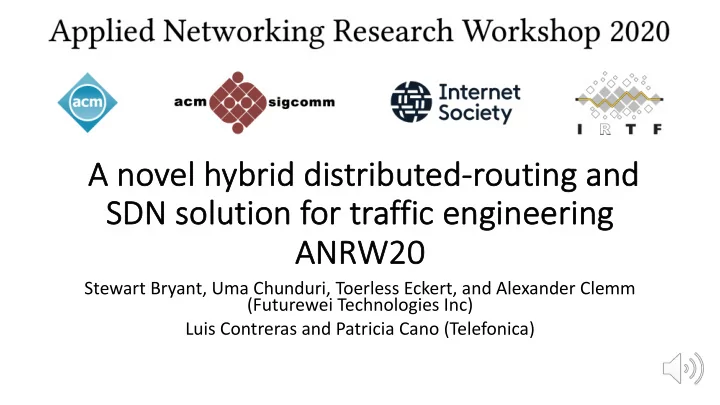

A A novel hyb ybrid distributed-ro routing and SDN N solution for traffic engineering ANR NRW20 Stewart Bryant, Uma Chunduri, Toerless Eckert, and Alexander Clemm (Futurewei Technologies Inc) Luis Contreras and Patricia Cano (Telefonica)
Traffic Engineering (TE) Needs • TE requirements are becoming more demanding. • SDN solutions work by calculating TE paths and allocating resources centrally, then communicating decisions to network nodes individually + Holistic view allows for better optimization - Less resilient against perturbations in network state - Delayed adaptation to network changes • Traditional routing relies on distributed algorithms + Fast adaptation to perturbation in network state - Considerable overhead in data synchronization - Local decisions may not always be globally optimal
Our Proposal • Our proposal: Hybrid solution to combine advantages of central and distributed approaches whilst avoiding the disadvantages: • Conceptually centralized components used to calculate TE Paths and resource allocations • Communicate this information in distributed manner using link-state routing protocols • Provide this service to multiple data planes (MPLS, MPLS-SR, IPv6, SRv6, IPv4, Ethernet)
PPR Overview • PPR provides a method of injecting paths into link-state IGPs. • In the data plane the packet is mapped to its intended path by the PPR-ID. • PPR-ID is a *single* identifier in the packet. • The format of the PPR-ID is data-plane specific (IPv6 addr, IPv4 addr, MPLS label, MAC Addr). • PPR Interop at IETF Hackathon July 2019 PPR-ID Data plane (packet) A A C D Control plane B PPR-ID=d C B D See draft-chunduri-lsr-isis-preferred-path-routing for encoding detail
Traffic Engineered Repair d d' A-??-B--??--C--??-D | | | | E----F------G-----+ • Primary path is A->B->C->D and is traffic • Need TE backup paths because: engineered • Critical SLA traffic must use FRR with • Backup path is A->E->F->G->D and is also traffic same SLA as primary: ( 5G uRLLC or engineered mIOT slices) • TE connectors provided from B and C to TE repair • High b/w traffic carried on TE paths path. must not saturate best effort shortest- • If A->B, or B->C or C->D fails single TE path can be path-LFA-path/shortest-path-post- used for repair convergent-LFA-path. Path injected from SDN controller at any node, or for resilience at a small number of nodes.
PPR Graphs • Described in draft-ce-lsr-ppr-graph • TLVs describe graph as a series of lists of paths • Any node may be a source • A source node is annotated with the S bit • Generally there is one destination node which has the D bit set. • The destination has a PPR-ID associated with it.
Simple Repair Graph • Repair is described in a single graph d' • Graph: A-??-B--??--C--??-D PPR-ID=d’ | | | | A(s)->E->F->G->D(d bit) E----F------G-----+ B(s)->F C(s)->G • Primary path is A->B->C->D • Backup path is A->E->F->G->D + B->F + C->G • If A->B, or B->C or C->D fails single PPR path can be used for repair
Centralized and Decentralized Approaches • PPR can support both centralized and decentralized computation of the repair path. • Any node can inject the PPR path either: • For itself as the PLR calculating its own repair paths • On behalf of an SDN controller managing the repair paths • Multiple nodes can inject the repair for redundancy and the duplicates will be eliminated by the IGP flooding process. • *Any* algorithm can be used to compute *any* path or graph - e.g. bespoke dis-joint path or lossless or low path. • Such paths are independent of any other path chosen for any other purpose.
Future: Per-hop Policy/Action d' A----B------C-----D d’’ | | | | E----F------G-----+ • Every hop can have its own individual policy installed by the control plane for each specific PPR path e.g. : • Queue behavior • Monitoring/OAM behavior • Path can be strategically installed by SDN controller, or tactically by edge node • Research Question: How do we define a suitable policy expression language for PPR? • Efficiency can be improved with Path-oriented Flooding • A->B->C->D to d’ needs red but not blue • A->E->F->G->D to d’’ needs blue not red • This needs to be done without compromising the flooding resilience that LSPs provide. • Research Question: How do we define a resilient flooding reduction system?
Future: Resilience and Robustness • We know how to build FRR based on PPR. • Research Question: Can we expand the PPR graph structures to provide TE between Detnodes nodes AND the add Packet Replication Elimination and Ordering (PREOF) functions to new data-planes such as IP? • A system has Byzantine robustness if it can withstand active lying by its components. • We know how to make link-state routing Byzantine robust. • High value (TE) and strategic services (5G) are prime targets for attack. • We are proposing to use a link-state protocol to set up TE paths • Research Question: Can we make traffic engineered paths that are robust against Byzantine attacks (or accidents)?
More Information sb@stewartbryant.com uma.chunduri@futurewei.com alex@futurewei.com toerless.eckert@futurewei.com luismiguel.contrerasmurillo@telefonica.com patricia.diezcano.ext@telefonica.com
Recommend
More recommend